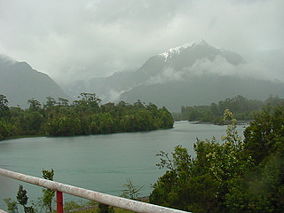
A nature reserve is a protected area of importance for flora, fauna, or features of geological or other special interest, which is reserved and managed for purposes of conservation and to provide special opportunities for study or research. They may be designated by government institutions in some countries, or by private landowners, such as charities and research institutions. Nature reserves fall into different IUCN categories depending on the level of protection afforded by local laws. Normally it is more strictly protected than a nature park. Various jurisdictions may use other terminology, such as ecological protection area or private protected area in legislation and in official titles of the reserves.

Chiloé Island also known as Greater Island of Chiloé, is the largest island of the Chiloé Archipelago off the west coast of Chile, in the Pacific Ocean. The island is located in southern Chile, in the Los Lagos Region.

The Valdivian temperate forests (NT0404) is an ecoregion on the west coast of southern South America, in Chile and Argentina. It is part of the Neotropical realm. The forests are named after the city of Valdivia. The Valdivian temperate rainforests are characterized by their dense understories of bamboos, ferns, and for being mostly dominated by evergreen angiosperm trees with some deciduous specimens, though conifer trees are also common.

Corcovado National Park is a National Park on the Osa Peninsula, in Osa Canton, southwestern Costa Rica, which is part of the Osa Conservation Area. It was established on 24 October 1975 and encompasses an area of 424 square kilometres (164 sq mi). It is the largest park in Costa Rica and extends over about a third of the Osa Peninsula. It is widely considered the crown jewel in the extensive system of national parks and biological reserves spread across the country. National Geographic has called it "the most biologically intense place on Earth in terms of biodiversity".

Douglas Rainsford Tompkins was an American businessman, conservationist, outdoorsman, philanthropist, filmmaker, and agriculturalist. He founded the North Face Inc, co-founded Esprit and various environmental groups, including the Foundation for Deep Ecology and Tompkins Conservation.

Pumalín Douglas Tompkins National Park is a 400,000-hectare (1,000,000-acre) national park in the Palena Province of Chile, created by Tompkins Conservation, which was endowed and led by the American business magnate Doug Tompkins and his wife, former CEO of Patagonia, Inc., Kris Tompkins. Designated a Nature Sanctuary in 2005, Parque Pumalín was Chile's largest private nature reserve and operated as a public-access park, with an extensive infrastructure of trails, campgrounds, and visitor centers. By an accord announced on 18 March 2017, the park was gifted to the Chilean state and became South America's largest national park.

Golfo Dulce is a gulf in Costa Rica, located at the south of the Province of Puntarenas. The inlet starts on the Pacific Ocean side of Costa Rica and extends slightly northward before turning west. The most westward part is at the city of Rincon. The bay separates the Osa Peninsula from the mainland Costa Rica.
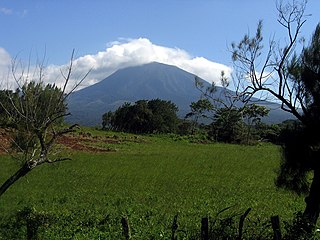
Guanacaste Conservation Area is an administrative area which is managed by the Sistema Nacional de Areas de Conservacion (SINAC) of Costa Rica for conservation in the northwestern part of Costa Rica. It contains three national parks, as well as wildlife refuges and other nature reserves. The area contains the Area de Conservación Guanacaste World Heritage Site, which comprises four areas.

Cerro Castillo National Park is a nature reserve of Chile located in the Aysén del General Carlos Ibáñez del Campo Region, south of Coyhaique. The park is named after Cerro Castillo, its highest mountain and main attraction. The Carretera Austral passes through the park.

The wildlife of Cameroon is composed of its flora and fauna. Bordering Nigeria, it is considered one of the wettest parts of Africa and records Africa's second highest concentration of biodiversity. To preserve its wildlife, Cameroon has more than 20 protected reserves comprising national parks, zoos, forest reserves and sanctuaries. The protected areas were first created in the northern region under the colonial administration in 1932; the first two reserves established were Mozogo Gokoro Reserve and the Bénoué Reserve, which was followed by the Waza Reserve on 24 March 1934. The coverage of reserves was initially about 4 percent of the country's area, rising to 12 percent; the administration proposes to cover 30 percent of the land area.
The Dungeness National Wildlife Refuge is located near the town of Sequim in Clallam County in the U.S. state of Washington, on the Strait of Juan de Fuca. The refuge is composed of 772.52 acres (312.63 ha) which include Dungeness Spit, Graveyard Spit, and portions of Dungeness Bay and Harbor. Dungeness Spit is one of the world's longest natural sand spits, 6.8 miles (10.9 km) long and very narrow. A lighthouse, the New Dungeness Light, built in 1857, is located near the end of the spit. Access to Dungeness Spit is through a Clallam County Park which has hiking trails, picnic areas, and a campground. On January 20, 1915, it was designated as a National Wildlife Refuge by President Woodrow Wilson. Dungeness is one of six refuges in the Washington Maritime National Wildlife Refuge Complex.
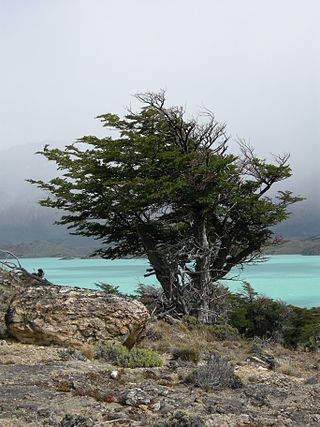
Perito Moreno National Park is a national park in Argentina. It is located in the western region of Santa Cruz Province on the border with Chile. It has an area of 126,830 hectares of mountains and valleys at a height of 900 metres above sea level.
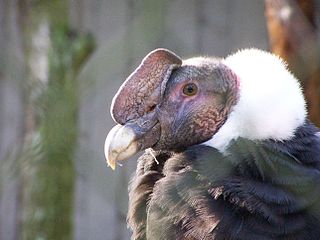
The wildlife of Chile is very diverse because of the country's slender and elongated shape, which spans a wide range of latitude, and altitude, ranging from the windswept coastline of the Pacific coast on the west to northern Andes to the sub-Antarctic, high Andes mountains in the east. There are many distinct ecosystems.

Kristine McDivitt Tompkins is the president and co-founder of Tompkins Conservation, an American conservationist, former CEO of Patagonia, Inc., a UN Patron of Protected Areas from 2018-2022. She has committed her career to protecting and restoring Chile and Argentina’s wild beauty and biodiversity by creating national parks, restoring the wildlife, inspiring activism, and fostering economic vitality as a result of conservation. Having protected over 14 million acres of parklands in Chile and Argentina through Tompkins Conservation and its partners, Kristine and Douglas Tompkins, her late husband who died in 2015, are considered some of the most successful national park-oriented philanthropists in history.

Conservación Patagónica was a conservation group with a mission "to create national parks in Patagonia that save and restore wildlands and wildlife, inspire care for the natural world, and generate healthy economic opportunities for local communities." Founded in 2000 by Kristine Tompkins, former CEO of Patagonia, Inc, Conservación Patagónica first focused on the creation of Monte León National Park in Argentina, the country's first coastal national park. The group played the central role in securing the funds for the purchase of Estancia Monte Leon and in creating long-term management plans for the new national park. As of December 31, 2018 Conservación Patagónica has merged into Tompkins Conservation.

Tanzania contains some 20 percent of the species of Africa's large mammal population, found across its reserves, conservation areas, marine parks, and 17 national parks, spread over an area of more than 42,000 square kilometres (16,000 sq mi) and forming approximately 38 percent of the country's territory. Wildlife resources of Tanzania are described as "without parallel in Africa" and "the prime game viewing country". Serengeti National Park, the country's second largest national park area at 14,763 square kilometres (5,700 sq mi), is located in northern Tanzania and is famous for its extensive migratory herds of wildebeests and zebra while also having the reputation as one of the great natural wonders of the world. The Ngorongoro Conservation Area, established in 1959, is a UNESCO World Heritage Site and inhabited by the Maasai people. Its Ngorongoro Crater is the largest intact caldera in the world.

Many areas of Vietnam are under protection. While the national reserves cover small areas of scientific significance with restricted access, the national parks also cover wetlands of Ramsar designated areas and BirdLife International inscribed bird areas. The largest of the national parks initially covered were the Cúc Phương National Park, the Cát Tiên National Park, and the Côn Đảo National Park which to start with were forest areas cum reserves or prohibited areas. The objective for creating national parks was to allow access to the reserved areas as a part of ecotourism and cultural needs with full attention to the basic approach of conservation of natural environmental resources.

Patagonia National Park is a National Park in the Aysén Region of Chile, once a private nature reserve operated as a public-access park, it was donated to the government of Chile by Tompkins Conservation in 2018.
Geegeela Conservation Park is a protected area in the Australian state of South Australia located in the state's south-east in the gazetted locality of Bangham about 277 kilometres (172 mi) north-west of the state capital of Adelaide and about 12 kilometres (7.5 mi) north-west of the town centre in Frances.
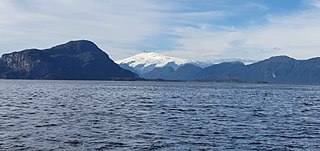
Melimoyu National Park is a protected area of Chile, located in the comuna of Cisnes, in the Aysén Region. The land for the creation of the park was assembled from public lands and estates donated by Tompkins Conservation, an organization founded by American conservationists Kristine and Douglas Tompkins, as part of a collaborative project to create a "National Parks of Patagonia Network".
